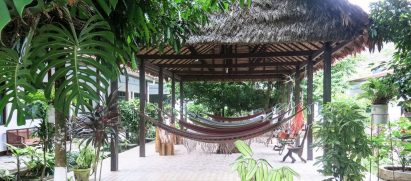When tobacco was first discovered by European voyagers in the sixteenth century, it provoked moral outrage at the prospect of a diabolic herb perforating its way into European society. It was used in Mesoamerican cultures for medicinal and spiritual benefits. As the tobacco plant was hotly debated amongst Europeans, its slow incorporation into western value systems allowed it to leap the cultural divide between the Americas and Europe, increasingly untying the plant from its indigenous past.

The traditional uses of tobacco are comparable with the indigenous uses of the ayahuasca plant; ceremonial, ritualistic, medicinal. Ayahuasca is one of the most ancient and sacred plants within the Amazonian indigenous communities. Traditionally it is ingested by a Shaman – a man of medicine, power and experience – and used as a tool for divination in the treatment of the illness they are curing.
The vine-plant contains a natural hallucinogenic element, DMT. It is chemically similar to magic mushrooms, thus provoking psychedelic visions. The DMT experience is not traditionally the point of drinking ayahuasca, but an element of interest for western travellers. The intense psychedelic visions provoked by the plants are said to change lives and provide deeper understanding of the realms. The DMT-centric view was what the psychedelic community took away from the plant and has transformed it into a source of curiosity, entertainment and exploitation.
Ayahuasca tourism is a growing industry in the Americas. The tourists are predominately wealthy, white, well-educated, spiritually eclectic individuals who spend time at a ‘spiritual retreat’ ingesting the plant for a variety of reasons: to provoke psychedelic visions, find answers to profound questions, personal growth and healing. As the industry expands, misuse of the plant is prevalent, for example through the street-selling of potentially fatal concoctions of ayahuasca. The Guardian reported a British backpacker died in Colombia in April 2014, after ingesting the drug at a ‘Shaman experience’, advertised to a group of tourists at the hostel. He was left to die at the side of the road.

The ayahuasca tourist, in search of a deep cosmic insight, often fails to understand the importance of the cultural context in which the drug is used. This parallels with the European discovery of tobacco in the sixteenth century; an attitude of disregard and criticisim of herbal ritualistic properties. When the herb’s functional purposes were separated from its spiritual properties, it was able to assimilate into European society, evolving into the addictive substance as it remains today.
Ayahuasca tourism has brought new attention, new money and new problems to the traditional communities. It has created a market for the misrepresentation of ceremonial practice and commercialisation of Native American traditions, but similarly the exploitation of eager and naïve tourists. The expanding industry of ayahuasca tourism, comparable with the assimilation of tobacco into sixteenth century Europe, raises questions surrounding the attitudes of the first European voyagers and the modern traveller.
To conclude, it is unclear whether the ingestion of plants is a continuum of cultural appropriation or an unending curiosity into indigenous cultures. One thing is certain, the search for ayahuasca among Western travellers shows no sign of slowing down, as the spiritual soul is hungry to provoke psychedelic visions in a quest to deepen their understanding of the world.
Vic xx